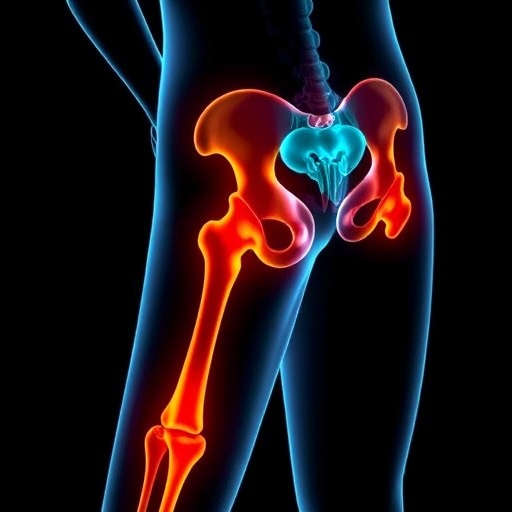In recent years, the global population has witnessed a transformative demographic shift, with an increasing proportion of people aged 85 and older. This segment of the population has unique health concerns, particularly around conditions that significantly affect quality of life and longevity. One such concern is the incidence of hip fractures, which carry profound implications for elderly patients. A study led by researchers in Northern Sweden has delved into the multifaceted aspects of mortality in individuals over 85 years of age who have suffered hip fractures, revealing critical factors that strain both healthcare systems and the patients themselves.
Hip fractures are alarming events among senior citizens, often precipitating a cascade of health complications. The fragility associated with aging makes bones increasingly susceptible to fractures from relatively minor falls or incidents. Once a person over 85 sustains a hip fracture, the road to recovery can be arduous, leading to extended hospital stays, rehabilitation, and potential long-term disability. For many elderly patients, these fractures signify not merely a physical injury but the harbinger of severe morbidity and possibly mortality.
The study conducted by Olofsson and her team focuses on the one-year mortality rate among those aged 85 and older following a hip fracture. By closely examining this demographic, the researchers aimed to identify predictive factors associated with mortality, thereby providing critical insights into post-fracture care and management. This inquiry is particularly relevant in light of the growing geriatric population that presents unprecedented challenges to healthcare providers everywhere.
The researchers utilized a comprehensive methodological approach, gathering data from various medical records and patient demographics in Northern Sweden. By analyzing health outcomes, comorbidities, and intervention strategies, they sought to create a clear picture of which factors contribute most significantly to adverse outcomes in this fragile age group. Among the myriad of elements considered were age-related variables, underlying health conditions, cognitive functionality, rehabilitation efficacy, and the patient’s overall support system.
Interestingly, one finding that stood out from previous studies was the significant role that pre-existing health conditions play in the post-fracture mortality landscape. Conditions such as heart disease, diabetes, and even frailty index scores were closely examined. Each of these chronic ailments not only has a direct impact on recovery but can also amplify the risk of mortality after such traumatic events. The interplay between these conditions and a patient’s resilience sheds light on how healthcare interventions might be tailored to improve prognostic outcomes.
Beyond the physical aspects of recovery, the study also underscores the psychological and social factors that contribute to mortality. It appears that individuals with a robust support network, including family, friends, and caregivers, have markedly better recovery trajectories than those lacking such connections. Emotional well-being plays a vital role, as does access to care services and community resources. The importance of integrating social work and psychological support into treatment regimens could be a pivotal takeaway for healthcare systems aiming to enhance recovery rates.
Furthermore, Olofsson et al. discuss the implications of surgical interventions. While surgical repair for hip fractures can significantly improve mobility and reduce pain, the decision to operate can often be influenced by other health complications present in elderly patients. Understanding when to prioritize surgery or alternative treatment approaches is crucial for optimizing outcomes. This finding serves as a compelling reminder for medical professionals to adopt a nuanced approach when dealing with this vulnerable population segment.
In the context of public health, the study’s implications extend far beyond individual patient outcomes. As the elderly population continues to rise, healthcare systems must adapt to accommodate increasing demands for orthopedic services. Effective preemptive strategies, including fall prevention programs, should be prioritized to reduce the incidence of hip fractures. Moreover, educational campaigns aimed at both elder citizens and their families regarding the prevention of falls could potentially minimize the frequency of these life-altering injuries.
Another vital aspect of the research is the recommendations for health policy changes based on the findings. For instance, creating integrated care models that ensure seamless transitions from hospital to home can greatly enhance post-fracture recovery. Policymakers must consider the allocation of resources towards rehabilitation services that provide comprehensive post-operative care for the elderly, thereby potentially reducing mortality rates and improving the quality of life.
The challenges presented by aging populations are far from exclusively a medical issue; they encompass social, economic, and ethical dimensions as well. Acknowledging the complexity of these factors is essential for fostering a holistic approach to elderly care. The longitudinal data emerging from studies like those of Olofsson et al. can inform these discussions, paving the way for evidence-based policies that enhance geriatric health outcomes.
In conclusion, Olofsson and her colleagues shed light on the intricate web of factors that influence one-year mortality outcomes after hip fractures in individuals over 85 years of age. Their findings underscore the importance of multidisciplinary approaches to care that encompass the physical, psychological, and social facets of recovery. As the demographic landscape continues to shift, research such as this will prove invaluable in guiding healthcare practices and policies tailored to the needs of the elderly population, ultimately improving their longevity and quality of life.
This comprehensive understanding of mortality risks following hip fractures can empower healthcare providers to make informed decisions, contributing to a paradigm shift in how we approach geriatric health management. As society rallies to support its aging members, the findings from Northern Sweden illuminate a promising path forward.
Subject of Research: Factors associated with one-year mortality after hip fracture in elderly individuals.
Article Title: Factors associated with one-year mortality after hip fracture in people older than 85 years in Northern Sweden.
Article References:
Olofsson, E., Gustafson, Y., Mukka, S. et al. Factors associated with one-year mortality after hip fracture in people older than 85 years in Northern Sweden. Eur Geriatr Med (2025). https://doi.org/10.1007/s41999-025-01317-6
Image Credits: AI Generated
DOI: https://doi.org/10.1007/s41999-025-01317-6
Keywords: Elderly care, hip fracture, mortality rates, health outcomes, rehabilitation, geriatric health.




